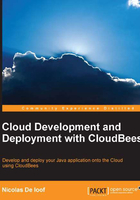
Private versus public Clouds
Many companies are interested in Cloud, thanks to the press for publishing all product announcements as the new revolution, and would like to benefit from them but as a private resource.
If you go back to the comparison in the Preface with an electricity production, this may make sense if you're well established. Amazon or Google should have private power plants to supply giant data centers can make sense—anyway it doesn't seems that they do but as backends. For most of companies, this would be a surprising company choice.
The main reason is that the principle of the Cloud relies on the last letter of XaaS (S) that stands for Service. You can install an OpenStack or VMware farm on your data center, but then you won't have an IaaS. You will have some virtualization and flexibility that probably is far better than traditional dedicated hardware, but you miss the major change. You still will have to hire operators to administer the servers and software stack. You will even have a more complex software stack (search for an OpenStack administrator and you'll understand). Using Cloud makes sense because there are thousands of users all around the world sharing the same lower-level resources, and a centralized, highly specialized team to manage them all.
Building your own, private PaaS is yet another challenge. This is not a simple middleware stack. This is not about providing virtual machine images with a preinstalled Tomcat server. What about maintenance, application scalability, deployment APIs, clustering, backup, data replication, high availability,monitoring, and support?
Support is a major added value of cloud services—I'm not just saying this because I'm a support engineer—but because when something fails, you need someone to help. You can't just wait with the promise for a patch provided by the community. The guy who's running your application needs to have significant knowledge of the platform. That's one reason that CloudBees is focusing on Java first, as this is the ecosystem and environment we know best (even we have some Erlang and Ruby engineers whose preferred game is to troll on this displeasing language).
With a private Cloud, you probably can have level-one support with an internal support team, but you can't handle all the issues. As for resource concentration, working in support with thousands of customers allows a public platform to build an impressive knowledge base.
All those topics are ignored in most cases as people only focus on the app:deploy automation, as opposed to the old-style deployments to dedicated hardware. If this is what you're looking for, you should know that Maven was able to do this for years on all the Java EE containers using cargo. You can check the same at http://cargo.codehaus.org. Cloud isn't just about abstracting the runtime behind an API; it's about changing the way in which developers manage and access runtime so that it becomes a service they can consume without any need to worry about what's happening behind the scene.